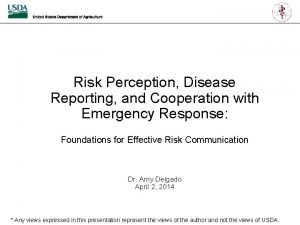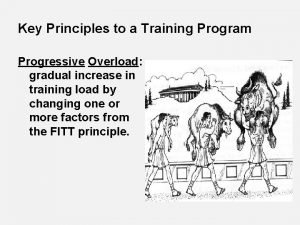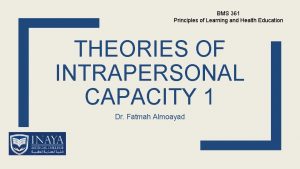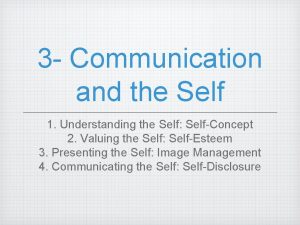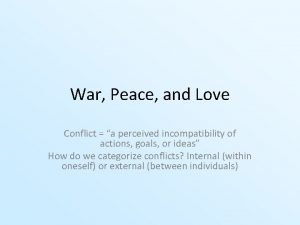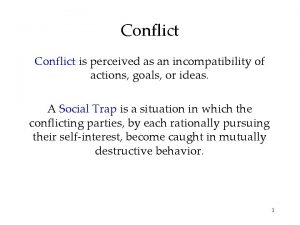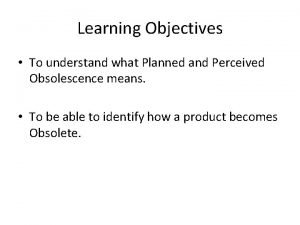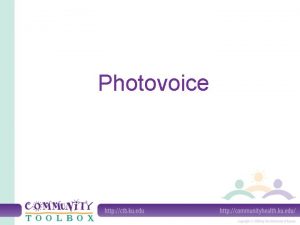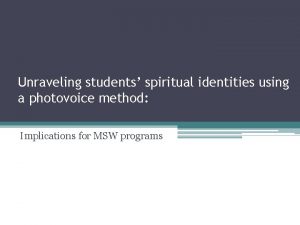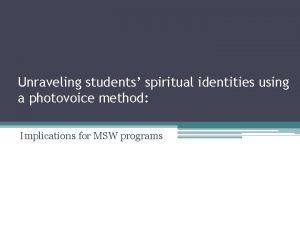Using photovoice to examine perceived consequences of sex


























- Slides: 26

Using photovoice to examine perceived consequences of sex among female adolescents Disa Lubker Cornish, MS Lucy Annang, Ph. D

Background p 47% of high school students had ever had sex in 2005 (61. 2% of African American females )1 p Nationally, 14% of high school students had sex with at least 4 lifetime partners 1 p 2002: national pregnancy rate for teens ages 15 to 19 was 76. 4 per 1, 0002 p Teen pregnancy rate declining since a peak in 1990 of 116. 8 per 1, 0002 p Nearly half of new cases of STDs in 2000 occurred in 15 to 24 year olds 3

Background p Antecedents of sexual initiation among adolescent females 4 n Protective factors p p n Feelings of guilt related to sexual activity Greater perceived costs of pregnancy Greater perceived risk of concern about STDs/HIV Greater perceived personal and social costs to sex Risk factors p p Permissive attitudes toward premarital sex and abstinence Greater perceived personal and social benefits to sex Dating at an early age or frequent dating Having a romantic relationship, going steady with a partner

Background p Adolescents’ perceptions regarding pregnancy/STD risk associated with dual contraceptive method use 5 p Young adolescent females (7 th-9 th grade) may be less likely to use dual methods if they view sex as a way to experience pleasure, appear attractive, and reduce loneliness 5

Purpose p To explore the perceived impacts of sex in a young population with a group of adolescent females in the 9 th grade using photovoice. p To gain a better understanding of how young females think about the potential consequences of sex.

Photovoice 6 p A qualitative method of inquiry p Individuals take photograph based on a specific topic p Then discuss the photographs and the meaning they associate with the photographs in a group setting

3 goals of photovoice 6 p Enables individuals to record and reflect their community's strengths and problems p Promotes dialogue about important issues through group discussion and photographs p Reaches and engages policymakers

"What experts think is important may not match what people at the grassroots think is important. " (Caroline Wang)

Photovoice and adolescents 7 p Photovoice method adapted for use with adolescents p Teen photovoice projects set outside of school environment p Benefits in this population n p Development of creative skills and creativity reflects youth development and theoretical underpinnings of the method Sense of pride in creative product contributes to discussion High levels of youth satisfaction and empowerment Challenges in this population n Variety in picture-taking rates and quality of photos Large-group discussions can hinder the dialogue; smaller and less heterogeneous groups may help Youth will need significant assistance in reaching policy level

4 Steps of Photovoice 6 p First, participants meet at an informational session where they are given and shown how to use a disposable camera p The group decides on a photo assignment p Second is the actual photography of their experiences as they relate to the first assignment. p Third, participants will meet to share their photos with one another and discuss them. p Fourth, they determine a way to present the photos and conclusions to policy makers or other community members. www. photovoice. com

During discussion 6 p Group discussion should involve reflection and dialogue – critical thought! p Participants… n Select photographs to discuss n Contextualize the photos and tell stories about what they represent n Codify issues and concerns www. photovoice. com

Methods p 2 sessions (N=13) p Conducted in a large high school in an urban area of a Southeast city n n p Partnered with a 9 th grade health teacher at the school Sessions conducted under the supervision of this teacher Sessions were held during class time n n Session 1: 30 minutes Session 2: 45 minutes

Methods cont. p IRB approval – led to project modification n n p Written informed consent obtained from all participants and their parents/guardians Incentive provided through school – extra credit in health class The IRB office was concerned about the potential ethical implications of minors putting themselves at risk n n n Sensitive topic Minors consenting minors through photo releases Required modification to remove the photographic element entirely p Participants created collages using print images and text found in magazines to express their views on the central topic p “What are the impacts, positive or negative, of having sex in a young population? ” p Formal qualitative analysis (code development and coding process)

Results – p p p 13 female participants 9 th grade at an urban high school in Birmingham, Alabama 12 African American, 1 White Primary impact/consequence # times in discussion # collages with theme (N=13) Pregnancy 10 13 Sexually transmitted diseases/infections 5 7 Psychological consequences 8 6

Collage #1

Results - Pregnancy p Father of the baby n p p “Husband has a question mark, like is he going to marry you just because you have a baby. ” Social/lifestyle changes n “Your whole life is going to be flipped. ” n “No more diamonds or anything you’d want, you have to give it all to the baby. ” n “…but you can venture out with your children. ” n “Everything isn’t about you anymore, it’s more about your children. ” Providing for the baby n n Financial concerns (“going to be broke, ” “have to shop for the baby”) “…opportunities because basically to make sure that you give them opportunities that you didn’t have. ”

Results – STI acquisition p Prospect of an STI worse than prospect of pregnancy n p “…having a baby ain’t always bad, having an STD is always bad. ” STIs are “forever” n “Cause an STD you might have to deal with that for the rest of your life. ”

Results – Psychological impacts p Loss of self-esteem and self-confidence after sex n p “…you can lose your entire sense of selfworth. ” Having regrets n “And almost everybody will wind up having regrets about something they do in this area, and it’s not good. ”

Results – Additional thoughts p Recognition that teen pregnancy is challenging n p “…you can’t take care of a child when you’re still a child. ” Know people who have gotten pregnant n “I know a girl, she got pregnant…She got put of the house, she had to live with her boyfriend. Her boyfriend’s mama put both of them out. ” p Do not know people who have gotten STI p Both a baby and STI can be forever, but a baby can be a good thing forever n n “No, a baby is beautiful. ” “Babies aren’t just a problem. It is bad, but it can be a good thing, sometimes. A baby can always be with you. Having a baby is, well it’s different because it’s not just a bad thing. ”

Conclusions p As expected, participants identified pregnancy and STIs as primary impacts of sex in a young population p Participants also clearly recognized potential psychological impacts of sex unrelated to pregnancy or STI acquisition p Clear dissonance was present between personal examples of negative pregnancy experiences and romanticized notions of pregnancy and raising children p Communication about pregnancy appears to be much more common than communication about STIs p Discussion was characterized by a lack of factual knowledge and reliance on anecdotal evidence

Conclusions p Extant literature suggests associations between antecedents and sexual behavior p These results provide a unique perspective by including the target population in the dialogue about their risk behaviors p As a qualitative pilot assessment, it provides a deeper understanding of the perceptions of a subsample of the target population

Limitations/Strengths p Small sample size p The project was modified, and did not include a photographic component p The time periods for discussion were brief p However, the creative process did allow candid discussion from participants – they were discussing their creative projects rather than sensitive topics p The theoretical underpinnings remained unchanged despite the methodological modifications p As an assessment tool, photovoice is a participatory method n Modification of the method for this research maintained the utility as an assessment tool n Participants were included in qualitative conversation about the issues

Recommendations p Incorporation of creative projects into reproductive health curricula may be an effective way of engaging adolescents p Asking adolescents to drive discussion on reproductive health issues respects their experiential knowledge and allows for didactic opportunities p Issues that can benefit from adolescent-driven discussion include condom availability, medically accurate reproductive health education, and curriculum modification p Lasting and effective change related to these issues requires action in the policy domain – dialogue with adolescents and other target populations who are not usually included in decision-making is necessary and positive

In closing… p “Pregnancy and sex. People talking like sex is basically like, you could die from having sex. If you have sex you’re taking a risk and you know you’re taking a risk. They make it sound like sex is so bad. You could get sick or you could get pregnant, you could. But it’s a possibility. [If you protect yourself] then you’ll be ok…Even if they do [know how] it don’t mean they’re going to do it. ”

References 1. 2. 3. 4. 5. 6. 7. Centers for Disease Control and Prevention. (2006). Youth Risk Behavior Surveillance – United States, 2005. MMWR, 55, SS 5. Ventura, et al. , accessed http: //www. cdc. gov/nchs/products/pubd/hestats/teenpreg 19902002/teenpreg 1990 -2002. htm Weinstock, H, Berman, S, Cates, W. (2005). Sexually transmitted diseases among American youth: incidence and prevalence estimates, 2000. Perspectives on Sexual and Reproductive Health, 36(1), 6 -10. Kirby, D. (2002). Antecedents of adolescent initiation of sex, contraceptive use, and pregnancy. American Journal of Health Behavior, 26(6), 473 -485. Sieving, R. , Bearinger, L. , Resnick, M. , Pettingell, S. , Skay, C. (2007). Adolescent dual method use: Relevant attitudes, normative beliefs and self-efficacy. Journal of Adolescent Health, 275. e 15– 275. e 22. www. photovoice. com Strack, R. , Magill, C. , Mc. Donagh, K. (2004). Engaging youth through photovoice. Health Promotion Practice, 5(1), 49 -58.

Contact information p Disa Lubker Cornish, MS University of Alabama at Birmingham dlubker@uab. edu (205) 975 -8086
 Sex sex sex
Sex sex sex Sex sex sex
Sex sex sex Secondary sexual characters
Secondary sexual characters Greenhouse sex
Greenhouse sex Xxtesticles
Xxtesticles How to make a photovoice
How to make a photovoice Caroline c wang
Caroline c wang What is photovoice
What is photovoice Sex determination and sex linkage
Sex determination and sex linkage Once a sex offender always a sex offender
Once a sex offender always a sex offender Sex linkage example
Sex linkage example Sex rat
Sex rat Social facilitation psychology
Social facilitation psychology Xyz color space
Xyz color space Adequate service expectations
Adequate service expectations Perceived risk
Perceived risk Borg scale
Borg scale The perceived relevance or importance of an ethical issue
The perceived relevance or importance of an ethical issue Perceived susceptibility
Perceived susceptibility The way one wishes to be perceived by others is one's .
The way one wishes to be perceived by others is one's . It is a perceived incompatibility of actions or goals
It is a perceived incompatibility of actions or goals Perceived professional image
Perceived professional image A perceived incompatibility of actions or goals is
A perceived incompatibility of actions or goals is Askep kehilangan dan berduka
Askep kehilangan dan berduka A symbol that is perceived visible
A symbol that is perceived visible Perceived obsolescence examples
Perceived obsolescence examples The perceived relevance or importance
The perceived relevance or importance















